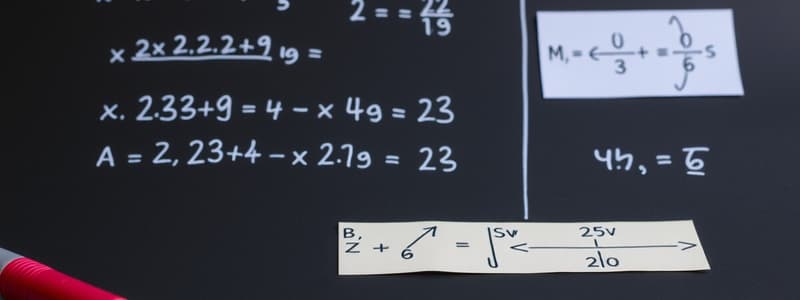Podcast
Questions and Answers
What is a relation?
What is a relation?
- The distance between two points
- A single point in the graph
- A set of ordered pairs (correct)
- An unbroken curve
What is an independent variable?
What is an independent variable?
the variable in a relation, usually x, with a value that is subject to choice
What is a dependent variable?
What is a dependent variable?
the variable in a relation, usually y, with values that depend on x
In a function, there can be multiple outputs for every input.
In a function, there can be multiple outputs for every input.
What is the domain of a function?
What is the domain of a function?
What is the range of a function?
What is the range of a function?
What is function notation?
What is function notation?
A discrete function has a graph that is an unbroken line.
A discrete function has a graph that is an unbroken line.
A continuous function has gaps or breaks in its graph.
A continuous function has gaps or breaks in its graph.
What is an x-intercept?
What is an x-intercept?
What is a y-intercept?
What is a y-intercept?
What is a relative maximum?
What is a relative maximum?
What is a relative minimum?
What is a relative minimum?
What is line symmetry?
What is line symmetry?
What defines a linear function?
What defines a linear function?
Flashcards are hidden until you start studying
Study Notes
Relations and Functions
- A relation is defined as a set of ordered pairs representing the relationship between variables.
- The independent variable, typically denoted as x, represents values chosen freely and influences the dependent variable.
- The dependent variable, usually referred to as y, takes values that rely on the output of the independent variable.
- A function is characterized by having precisely one output for each input, ensuring predictability in the relationship.
- The domain encompasses all possible input values of a function, determining what x-values can be used.
- The range includes all potential output values of a function, reflecting the resulting y-values.
- Function notation provides a clear, systematic way to express a function, detailing inputs and corresponding outputs concisely.
- A discrete function is represented graphically by isolated points, indicating distinct, non-continuous outputs.
- In contrast, a continuous function displays a graph as an unbroken line or curve, indicating no interruptions in values.
Graph Characteristics
- An x-intercept is the point where the graph crosses the x-axis, characterized by the y-coordinate being zero.
- A y-intercept is where the graph crosses the y-axis, identified by the x-coordinate being zero.
- Relative maximum points on a graph signify locations where neighboring points do not exceed the y-coordinate, indicating potential peaks.
- Relative minimum points are those where no nearby points have a lesser y-coordinate, signifying valleys in the graph.
Symmetry and Function Types
- Line symmetry refers to a situation where a line divides a figure into two halves that are mirror images, indicating symmetry in the graph.
- A linear function is defined by a graph that forms a straight line, representing a constant rate of change between variables.
Studying That Suits You
Use AI to generate personalized quizzes and flashcards to suit your learning preferences.




